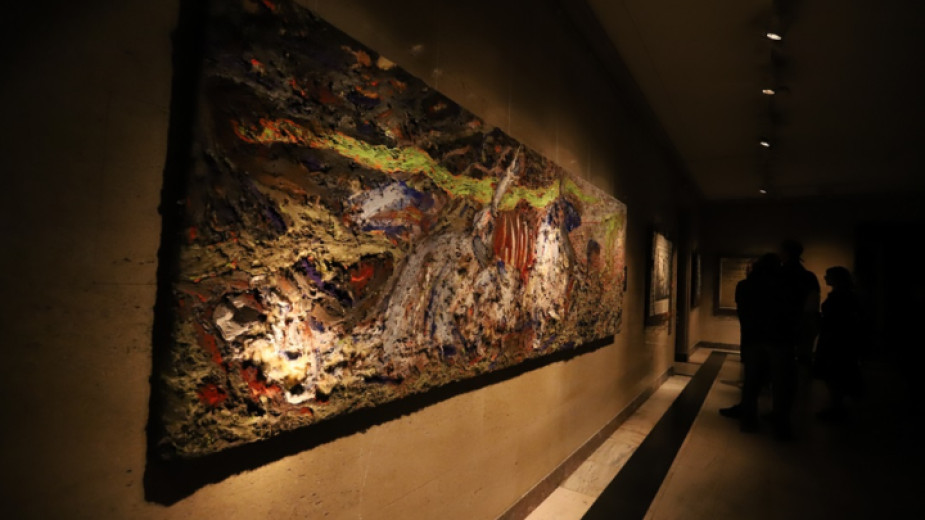 7
7
Historical knowldege is an immense wealth which can be reached if one has curiosity and a bit of critical thinking. These days we need to be "rich" more than ever and a young woman reminds us of this through the power of art. She is Yona Tukuser - an artist and a Bessarabian Bulgarian from a family of immigrants who left Stara Zagora back in 1832. She was born in the village of Glavan, Odessa region in Ukraine. In Hebrew her name means ‘dove’ and is a hereditary nickname from her mother.

"I am like a dove of peace," the artist, whose actual name is Lyudmila, says. Her paintings are an emotional provocation to all of us, but one should not expect seeing colorful pastoral landscapes. For 13 years, Yona has been working on her scientific and artistic project, dedicated to the three periods of famine in the USSR from the first half of the 20th century and the people who lost their lives during that time. Her latest exhibition "Hunger" in the National Gallery "Kvadrat 500" in Sofia, which can be seen until November 27, is part of the project and was realized with the support of the Embassy of Ukraine in Bulgaria. "Hunger is often the result of war," says Yona Tukuser in the studio of Radio Bulgaria.
It all started in 2007, when the young girl arrived in Sofia to study painting at the Academy of Fine Arts. During talks and informal conversations with her fellow students, who were very curious about the Bulgarians in Ukraine, she began telling them about events and periods of their history.
"And then I told them about one of the darkest pages of history for my countrymen since World War II. In 1946, Bessarabia was annexed by the USSR and collectivization began, with all able-bodied men sent to work in labor camps in Siberia. Mainly women, children and the elderly remained in the villages. Collective farms (kolkhoz) started to be created, but the Bulgarians refused to be part of them. In order to force them to join, the authorities took all their food, grain and animals.
Those who refused to join the collective farms were left to starve. My great surprise was that my fellow students did not know about this. In that period more than 100,000 Bulgarians died of starvation in Bessarabia, which was 1/3 of the entire ethnic population of Odessa region."
It was the historical ignorance of part of young Bulgarians in her ancestral homeland that provoked Yona to start her project "Hunger" back in 2009 using the means of art and painting.
"Each painting is a historical document, because I work with archive documents from the city of Izmail and the city of Odessa. I was looking for the personal stories of people, because for me this is not just a matter of statistics," Yona says.

"In 2018 I visited a number of Bulgarian villages in Ukraine and conducted video interviews with 86 people, direct witnesses of the events from our past. They told me how they survived the famine and I found out the same formula was used against people in the villages to keep them under control. We are talking about a war against the peasantry throughout the Soviet Union. People in the cities hardly knew what was happening in the countryside. When I talked to the elderly Bulgarians and asked them if war or famine was scarier, all of them answered me that it was famine. I was horrified by this fact because I had no idea that there was something more terrible than war. But there it is - hunger, which is a consequence of the war and is a threat to the whole world."
When Russia launched its current war in Ukraine, Yona was in her home village, where she returned after 10 years of living in New York, Rome and London. Just as she finished renovating a barn-turned-studio and bought 80 large canvases that were to become the last paintings for the Hunger Project, the war started. She returned to Sofia and history continued its course.
"Peace is a collective responsibility as everyone is afraid of the possibility of nuclear bombs exploding. This affects everyone. What is happening in my homeland concerns everyone.”

According to Yona, it is easier to reach the hearts of people through art. She has presented facts and details that she says are difficult to find in official documentation. A sealed spiritual document - this is how the artist describes her works.
"I can still see a sleeping society. With my exhibition I want to shed light on a part of history that is not widely-known, but is being repeated. My message in the exhibition is for suffering to serve for unification, not division and enmity."

Talks are underway in order for the exhibition "Hunger" to be shown in national galleries and museums in Italy, Germany and Great Britain, but before that Yona Tukuser will continue to paint in Sofia hoping that the dark periods of history would stop repeating.
English: Al. Markov
Photos: provided by the organisers, BGNESWe know her as the gymnast who broke boundaries by becoming the first woman in history to compete in four Olympic Games, proving that her sport is not just for young girls, but for women too. Today, she is an actress and writer. But above all, she is a..
Born on May 24, Kalina Tomova is among the most active and successful young musicologists in Europe. From a very young age, Kalina has shown her music talent, playing the piano, singing in the Bulgarian National Radio Children's..
Dimitar Kokov has lived in Portugal for 25 years and defines himself as a polyvalent person. In his role as an entrepreneur, he founded several companies. Among them there is one for software services, which works with clients from..

+359 2 9336 661
